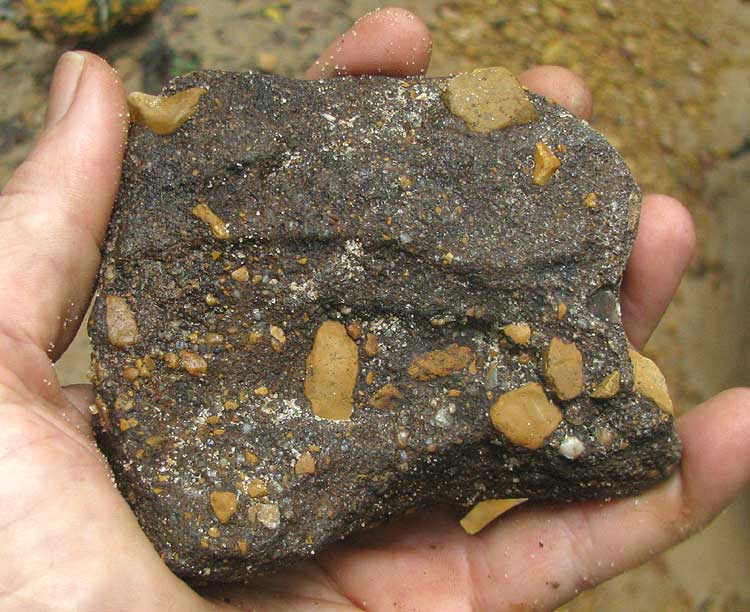Excerpts from Jim Conrad's
Naturalist Newsletter

from the August 26, 2012 Newsletter written at the woods edge in the Loess Hill Region a few miles east of Natchez, Mississippi, USA
CHUNKS OF FERRICRETE
Sometimes embedded in the sand of the usually dry floor of our local deep ravines you find very heavy items such as what is shown above. There you see particles of sand and gravel cemented together by a hard, dark substance into a rock. Here's that rock's story:
Here twelve miles east of Natchez and the Mississippi River our landscape is buried beneath a layer of maybe 20 to 40 feet of loess, which was deposited by wind at the end of the Ice Age about 15,000 years ago. The loess rests upon layers of unconsolidated, or loose, sand and gravel deposited by running Ice-Age water draining from the north some 700,000 years ago. Agate pebbles occur in the gravel, so we know that at least some of the gravel originated in the Lake Superior area, for that's the only source of agate upslope from us.
In geological terms, our buried sand and gravel's 700,000 year age is young. Its geological youth explains why it is unconsolidated: It simply hasn't had time for its particles to fuse into rock -- the sand to form sandstone and the pebbly gravel to form conglomerate. The same is true for nearly all the geology of the Deep South's lowland Coastal Plain Province. In short, in our area if you see a rock, nearly always it's been transported from someplace else with an older geology.
However, the heavy item in my hand in the above picture is an exception to the usual rock-forming process. It's a locally produced, very young rock. The usual rock-forming process, called lithification, consists of being buried deeply underground with tremendous weight squeezing from above over long periods of geologic time, or else melting in the proximity of molten magma or lava, and cooling into hard rock. Our rock could form so quickly because it lithified by a different process. It became a rock through chemistry. Basically, the sand and gravel particles "rusted together" just like a can of nails if left in standing water in a shed for a few years.
The item in my hand can be called ferricrete, which is defined as a hard, erosion-resistant layer of material at or near the land surface, consisting of sediments from non-local materials transported from elsewhere, cemented by iron oxide. The iron forms "rust" that fuses surrounding particles together. The word ferricrete is derived from the combination of ferruginous and concrete.
Sometimes here in southwestern Mississippi we find thin horizons of ferricrete with unconsolidated sand and/or gravel both above and below it. The ferricrete is hard, so it drastically slows the erosion process. Steep drop-offs can form at the ferricrete layer's edge. Sometimes loose sand and gravel wash from beneath the ferricrete layer so that the ferricrete layer projects a bit into open space. And sometimes chunks of overhanging ferricrete break off and wash downstream.
That's the history of the item in my hand in the photograph.